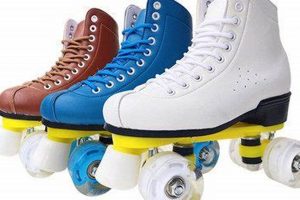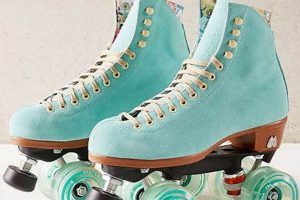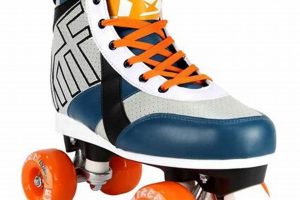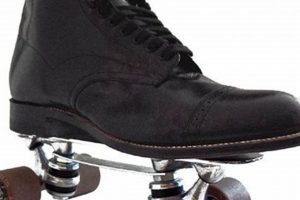These components, crucial for mobility, consist of a wheel mounted within a frame or fork, allowing the roller skate to roll smoothly across surfaces. They facilitate directional changes and contribute significantly to the overall skating experience. The wheel material, size, and hardness, along with the bearing quality within the assembly, influence the speed, grip, and durability of the skate.
The functionality of these components is paramount to the safety and enjoyment of skating. Selecting appropriate materials and designs can dramatically affect performance, stability, and maneuverability. Historically, advancements in materials science and engineering have led to significant improvements in wheel design, resulting in enhanced skating experiences across various disciplines, from recreational skating to competitive sports.
The following sections will delve deeper into the specific types, materials, maintenance considerations, and selection criteria associated with these essential rolling assemblies for roller skates. This will provide a comprehensive understanding of how these elements impact the performance and longevity of roller skates.
Roller Skate Caster Optimization
Optimizing the performance and lifespan of a roller skate assembly requires attention to several key areas. Proper selection, maintenance, and usage are critical to ensuring a safe and enjoyable skating experience.
Tip 1: Wheel Hardness Selection: The durometer, or hardness, of the wheel should match the intended skating surface. Softer wheels (lower durometer) provide greater grip on slick surfaces but wear down faster. Harder wheels (higher durometer) roll faster on smooth surfaces but offer less grip. Evaluate the typical skating environment to choose the optimal hardness.
Tip 2: Bearing Maintenance: Regular cleaning and lubrication of the bearings within the caster assembly are essential. Accumulated dirt and debris can impede rolling efficiency and accelerate wear. Use a solvent-based cleaner designed for bearings and re-lubricate with a high-quality lubricant after cleaning.
Tip 3: Frame Alignment: Ensure that the frame or fork holding the wheel is properly aligned. Misalignment can lead to uneven wear on the wheels and reduce stability. Consult the skate manufacturer’s specifications for proper alignment procedures.
Tip 4: Wheel Rotation: Periodically rotate the wheels to promote even wear. Wheels often wear more on one side due to skating style and surface conditions. Rotating the wheels helps extend their lifespan and maintains consistent performance.
Tip 5: Regular Inspection: Routinely inspect the assembly for signs of damage, such as cracks, chips, or loose components. Replace any damaged parts immediately to prevent potential accidents.
Tip 6: Proper Storage: Store roller skates in a dry, clean environment to prevent corrosion and degradation of the wheels and bearings. Avoid exposure to extreme temperatures and direct sunlight.
Tip 7: Consider the Skating Style: The optimal wheel type and hardness can differ greatly depending on the skating style. Aggressive skaters may prioritize durability, while speed skaters might prioritize lower rolling resistance. Choose components that align with the intended application.
By implementing these tips, users can maximize the performance, safety, and longevity of the wheel system, resulting in a more rewarding skating experience.
The subsequent sections of this document will explore further considerations for the replacement and customization of the roller skate’s rolling assembly.
1. Wheel Durometer
Wheel durometer, a measure of a wheel’s hardness, significantly impacts the functionality and performance of the wheel assembly in roller skates. The durometer rating, typically expressed on the A scale, dictates the wheel’s grip, speed, and durability characteristics, influencing the overall skating experience.
- Grip and Surface Interaction
The durometer rating determines how the wheel interacts with the skating surface. Softer wheels (lower durometer values) provide greater grip, particularly on slick or uneven surfaces. This enhanced grip is beneficial for skaters who prioritize stability and control, especially when performing maneuvers or navigating challenging terrains. Conversely, harder wheels offer reduced grip but can roll faster on smooth surfaces.
- Speed and Rolling Resistance
Wheel hardness is inversely related to rolling resistance. Harder wheels (higher durometer values) experience less deformation under load, resulting in lower rolling resistance and increased speed. Speed skaters often prefer harder wheels to maximize their velocity. Softer wheels, while offering superior grip, generate more friction and therefore reduce speed.
- Wear and Durability
The durability of a skate wheel is directly influenced by its durometer. Softer wheels wear down more quickly than harder wheels, especially when used on abrasive surfaces. This increased wear is due to the greater deformation and material loss that occurs with softer compounds. Harder wheels, being more resistant to abrasion, offer greater longevity but may sacrifice some grip.
- Skating Style and Application
The optimal wheel durometer is dependent on the intended skating style and application. Recreational skaters may benefit from a balance between grip and durability, while aggressive skaters often prioritize durability and impact resistance. Speed skaters require harder wheels for maximum speed, and artistic skaters may choose wheels based on the specific demands of their routines. Understanding these nuances is crucial for selecting the appropriate wheel for the desired skating experience.
In summary, wheel durometer is a critical parameter influencing the performance characteristics of the rolling assembly in roller skates. The selection of an appropriate durometer value requires careful consideration of the skating surface, desired speed, level of grip, and anticipated wear. By understanding the relationship between wheel hardness and these factors, skaters can optimize their equipment for enhanced performance and enjoyment.
2. Bearing Precision
Bearing precision, measured by the Annular Bearing Engineers’ Committee (ABEC) scale or similar ISO standards, directly influences the performance of roller skate rolling assemblies. Higher precision bearings exhibit tighter tolerances, resulting in reduced friction and increased rotational efficiency. This translates to greater speed and smoother rolling characteristics for the skater. In roller skate applications, the bearings within the wheel assemblies are subjected to significant radial and axial loads, necessitating precise construction to maintain optimal performance and durability. For example, a speed skater utilizing high-precision ABEC-7 bearings will experience a noticeable advantage in terms of speed and glide compared to using lower-rated bearings. The reduced friction minimizes energy loss, allowing for more efficient power transfer from the skater to the wheels. Conversely, lower precision bearings may exhibit increased wobble and friction, negatively impacting speed and energy expenditure.
The selection of appropriate bearing precision also depends on the skating discipline and intended use. While high-precision bearings offer advantages in terms of speed and efficiency, they can be more susceptible to damage from impacts and debris. Aggressive skaters who perform jumps and tricks may opt for slightly lower precision bearings with increased durability. These bearings are designed to withstand higher impact forces and are less likely to be damaged by contaminants. Furthermore, bearing precision impacts the maintenance requirements of the rolling assembly. High-precision bearings typically require more frequent cleaning and lubrication to maintain their performance characteristics. Failure to properly maintain these bearings can lead to premature wear and degradation, negating the benefits of their enhanced precision. An example of this would be neglecting regular maintenance which can lead to dirt and debris accumulating inside the bearings, causing increased friction and eventually failure.
In conclusion, bearing precision is a critical factor influencing the performance and longevity of the wheel system within roller skates. Selecting the appropriate level of precision requires careful consideration of the skating style, environmental conditions, and maintenance capabilities. While high-precision bearings offer significant advantages in terms of speed and efficiency, lower precision bearings may be more suitable for applications where durability and impact resistance are paramount. Understanding the trade-offs between precision, durability, and maintenance is essential for optimizing the performance of roller skates and ensuring a safe and enjoyable skating experience. Further research into bearing materials and lubrication techniques is ongoing, with the aim of developing bearings that offer both high precision and enhanced durability for a wider range of skating applications.
3. Frame Material
The frame material directly impacts the performance and durability of the complete roller skate wheel assembly. The frame’s primary function is to securely house the wheels and bearings, maintaining precise alignment and transferring the skater’s weight and momentum. Material choice dictates the frame’s stiffness, weight, and resistance to deformation under stress. For example, a frame constructed from high-grade aluminum alloy provides a superior strength-to-weight ratio compared to plastic alternatives. This translates to improved responsiveness and power transfer during skating maneuvers. Conversely, a frame made from a less rigid material may flex under load, leading to reduced efficiency and potential instability. Frame material must be resistance to external impacts.
Different frame materials cater to varying skating styles and performance requirements. Aggressive skaters, who perform jumps and grinds, often prefer frames constructed from hardened steel or reinforced composites. These materials offer enhanced impact resistance and prevent bending or cracking during high-stress maneuvers. Speed skaters, on the other hand, prioritize lightweight frames made from carbon fiber or advanced aluminum alloys. These materials minimize weight, reducing inertia and maximizing acceleration and top speed. The choice of frame material also affects the wheel size and configuration that can be accommodated. Stiffer frames generally allow for larger wheel diameters, which can improve rolling efficiency and stability. The choice depends on the users.
In conclusion, the selection of frame material is a crucial consideration when evaluating roller skate wheel assemblies. The material’s properties directly influence the frame’s stiffness, weight, and durability, impacting overall skating performance and longevity. By understanding the relationship between frame material and skating application, users can select appropriate equipment that meets their specific needs and maximizes their skating experience. However, it should be noted that quality of a frame is paramount.
4. Wheel Diameter
Wheel diameter, a critical parameter of roller skate rolling assemblies, directly influences speed, maneuverability, and overall skating performance. A larger diameter wheel generally translates to greater top speed due to a larger circumference covering more ground per revolution. However, this comes at the expense of acceleration and maneuverability, as larger wheels require more force to initiate movement and change direction. Conversely, smaller diameter wheels offer quicker acceleration and enhanced maneuverability, making them suitable for activities requiring agility and responsiveness.
The practical significance of wheel diameter selection becomes apparent when considering different skating disciplines. For instance, speed skaters typically utilize wheels with larger diameters (e.g., 100mm to 125mm) to maximize speed and maintain momentum over long distances. In contrast, aggressive skaters who perform tricks and stunts favor smaller diameter wheels (e.g., 55mm to 60mm) for improved control and responsiveness on ramps and rails. Recreational skaters often opt for an intermediate wheel diameter (e.g., 70mm to 80mm) that strikes a balance between speed, maneuverability, and stability. Furthermore, the frame design of the roller skate must accommodate the chosen wheel diameter. Improper frame selection can lead to wheel rub, instability, and reduced performance.
Understanding the relationship between wheel diameter and skating performance is crucial for selecting the appropriate wheel system. Challenges arise when skaters attempt to use wheel diameters not intended for their chosen discipline or skate frame. The optimal wheel diameter will vary depending on the skater’s skill level, skating environment, and desired performance characteristics. Selecting the right wheel ensures optimal efficiency, improved stability, and enhanced control and enjoyment.
5. Mounting System
The mounting system forms the critical interface between the roller skate boot and the wheel assembly, ensuring secure attachment and optimal performance. The effectiveness of this system directly impacts stability, control, and energy transfer during skating. A poorly designed or improperly installed mounting system can lead to instability, reduced responsiveness, and even catastrophic failure, compromising the skater’s safety. Different styles exist, each suited to specific skating disciplines and boot designs. For example, a standard plate-mounted system is common in recreational and artistic skating, offering a balance of adjustability and durability. Conversely, inline skate-style systems often feature integrated frames directly attached to the boot, maximizing power transfer and reducing weight.
The selection of a compatible mounting system is paramount when replacing or upgrading wheel assemblies. The bolt pattern, frame dimensions, and boot compatibility must align precisely to ensure a secure and reliable connection. Mismatched components can lead to stress concentrations, loosening of fasteners, and ultimately, failure of the assembly. Furthermore, the material and construction of the mounting system influence its ability to withstand the forces generated during skating. High-quality systems utilize durable materials such as aluminum alloys or reinforced composites to provide strength and resistance to deformation. Consider skaters performing advanced maneuvers; high-impact stresses demand robust mounting systems capable of withstanding extreme forces without compromising structural integrity.
In conclusion, the mounting system is an integral component of roller skate wheel assemblies, directly influencing performance and safety. Proper selection, installation, and maintenance of this system are essential for optimizing the skating experience. The skating environment, the skating style, and the level of experience all dictate mounting choices. The challenge lies in correctly assessing the intended use and matching it to a suitable system to ensure a secure, efficient, and reliable connection between the boot and rolling components. The choice of the proper system greatly optimizes performance.
Frequently Asked Questions
This section addresses common inquiries regarding roller skate wheel assemblies, providing detailed explanations to assist in informed decision-making.
Question 1: What constitutes a “roller skate caster,” and what are its primary components?
The assembly comprises a wheel, bearings, and a frame (or fork) that connects the wheel to the roller skate boot. The wheel facilitates rolling motion, bearings minimize friction, and the frame provides structural support and alignment.
Question 2: How does wheel durometer affect roller skating performance?
Wheel durometer, measured on the A scale, indicates wheel hardness. Softer wheels (lower durometer) offer greater grip but reduced speed and durability. Harder wheels (higher durometer) provide higher speed and durability but less grip. The selection should align with the skating surface and intended style.
Question 3: What role do bearings play in the efficiency of roller skate wheel assemblies?
Bearings reduce friction between the wheel and axle, enabling smoother and faster rolling. Higher precision bearings, often rated on the ABEC scale, offer tighter tolerances and reduced friction, enhancing performance.
Question 4: How frequently should roller skate wheel assemblies be maintained?
Maintenance frequency depends on usage intensity and environmental conditions. Routine cleaning and lubrication of bearings are essential to prevent dirt and debris accumulation. Regular inspection for damage or wear is also necessary to ensure safe operation.
Question 5: What factors should be considered when replacing “roller skate casters?”
Compatibility with the skate boot, wheel size, durometer, bearing precision, and frame material must be considered when replacing wheel assemblies. The chosen components should align with the skater’s skill level, skating style, and intended environment.
Question 6: What are the potential safety implications of using damaged or improperly maintained roller skate rolling assemblies?
Damaged or poorly maintained assemblies can compromise stability, reduce control, and increase the risk of accidents. Worn bearings, cracked wheels, or misaligned frames can lead to unexpected falls or injuries.
Understanding these key aspects of wheel assemblies is crucial for ensuring safe, efficient, and enjoyable roller skating. Proper selection and maintenance contribute significantly to the overall performance and longevity of the equipment.
The following section explores common issues and troubleshooting tips related to roller skate wheel assemblies.
Conclusion
This article has provided a comprehensive exploration of the functionality, importance, and considerations surrounding roller skate casters. It has highlighted the interplay between wheel durometer, bearing precision, frame material, wheel diameter, and mounting systems in achieving optimal skating performance. Proper selection and maintenance of these components are critical for skater safety and satisfaction.
Continued advancements in materials science and engineering promise further refinements in roller skate wheel assembly design. A commitment to rigorous inspection, timely replacement of worn parts, and adherence to recommended maintenance practices will ensure reliable performance and extend the lifespan of roller skates for all users. Prioritize safety and informed equipment choices for a rewarding skating experience.







